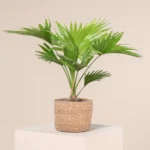Categories: Houseplants, Succulents, Air-Purifying Plants, Low-Maintenance Plants, Bedroom Plants
Introduction:
The Snake Plant, scientifically known as Sansevieria trifasciata (recently reclassified as Dracaena trifasciata), is a hardy and striking houseplant that has stood the test of time in interior design. Native to tropical West Africa, this plant is known for its tall, upright leaves with distinctive patterns, earning it nicknames like “Mother-in-Law’s Tongue” and “Viper’s Bowstring Hemp.”
Mastering the Art of Snake Plant Care: From Neglect to Thriving
In its natural habitat, Snake Plants can grow in a wide range of conditions, from full sun to low light areas of the forest floor. This adaptability has made it an ideal houseplant, capable of thriving in various indoor environments. The genus Sansevieria was named after Raimondo di Sangro, the Prince of Sansevero, an 18th-century inventor from Naples, Italy.
Real-world event: In 2019, a study published in the Journal of Environmental Management highlighted the Snake Plant as one of the most effective plants for removing indoor air pollutants, particularly formaldehyde, reinforcing its popularity in homes and offices.
Care Guide:
- Light: Tolerates low light to bright indirect light. Can handle some direct sun.
- Water: Allow soil to dry completely between waterings. Drought-tolerant.
- Humidity: Adapts well to any humidity level.
- Temperature: Prefers 70-90°F (21-32°C). Can tolerate down to 50°F (10°C).
- Fertilizer: Feed sparingly, 2-3 times during the growing season with a balanced fertilizer.
Soil and Potting/Repotting:
- Soil: Well-draining, sandy soil mix. Cactus or succulent mix works well.
- Potting: Choose a pot with drainage holes. Terracotta pots are ideal.
- Repotting: Every 2-3 years or when rootbound, preferably in spring.
Health and Diseases:
- Common pests: Mealybugs, spider mites
- Diseases: Root rot (from overwatering)
- Prevention: Proper watering, good air circulation, avoiding overwatering
Business: How to Make Money and Beyond
- Propagation and Sales:
- Propagate through leaf cuttings or division
- Sell mature plants or propagated starts online or at local markets
- Plant Styling Services:
- Offer interior design consultations featuring Snake Plants
- Create and sell pre-made arrangements combining Snake Plants with other succulents
- Content Creation:
- Start a blog or YouTube channel on low-maintenance houseplants
- Develop e-books or courses on succulent care featuring Snake Plants
- Specialty Products:
- Design custom planters specifically for Snake Plants
- Create air-purifying plant packages for offices and homes

Variety and Price Table:
| Variety | Average Price (USD) |
|---|---|
| Sansevieria trifasciata | $15 – $40 |
| Sansevieria ‘Laurentii’ | $20 – $50 |
| Sansevieria ‘Moonshine’ | $25 – $60 |
| Sansevieria cylindrica | $20 – $45 |
| Sansevieria ‘Black Gold’ | $30 – $70 |
Regional Price Comparison Table:
| Country/Region | Average Price (Local Currency) |
|---|---|
| USA | $20 – $50 USD |
| UK | £15 – £40 GBP |
| Australia | $25 – $65 AUD |
| Canada | $25 – $60 CAD |
| Japan | ¥2,000 – ¥5,000 JPY |
FAQs:
- Q: How often should I water my Snake Plant?
A: Water when the soil is completely dry, typically every 2-6 weeks. - Q: Can Snake Plants survive in low light?
A: Yes, they’re very tolerant of low light conditions. - Q: Are Snake Plants toxic to pets?
A: Yes, they’re mildly toxic if ingested by cats and dogs. - Q: How do I propagate my Snake Plant?
A: Through leaf cuttings or by dividing the plant during repotting. - Q: Why are my Snake Plant’s leaves falling over?
A: Often due to overwatering or insufficient light. - Q: Do Snake Plants flower?
A: Yes, but it’s rare indoors and the flowers are often inconspicuous. - Q: How fast do Snake Plants grow?
A: They’re slow growers, adding 1-3 new leaves per growing season. - Q: Can I put my Snake Plant outside?
A: Yes, in warm climates (USDA zones 9-11) or as a summer patio plant in cooler areas. - Q: How do I clean the leaves of my Snake Plant?
A: Wipe gently with a damp cloth to remove dust. - Q: Why are the tips of my Snake Plant turning brown?
A: Often due to underwatering, low humidity, or fluoride in tap water.
Quick Facts Table:
| Attribute | Detail |
|---|---|
| Scientific Name | Dracaena trifasciata (formerly Sansevieria trifasciata) |
| Common Names | Snake Plant, Mother-in-Law’s Tongue |
| Native Region | Tropical West Africa |
| Plant Type | Succulent |
| Mature Size | 6 inches to 8 feet tall |
| Growth Rate | Slow |
| Leaf Shape | Upright, sword-like |
| Flowering | Rare indoors |
| Light Requirement | Low to bright indirect light |
| Water Requirement | Low |
| Humidity | Adaptable to any humidity |
| Temperature Range | 70-90°F (21-32°C) |
| Soil Type | Well-draining, sandy |
| Toxicity | Mildly toxic to pets |
| Propagation Methods | Leaf cuttings, division |
| Air Purification | Excellent at removing formaldehyde |
Snake Plant, Sansevieria, Mother-in-Law’s Tongue, low-maintenance plants, air-purifying plants, succulents, drought-tolerant plants, indoor plants, bedroom plants, office plants

Views: 3







